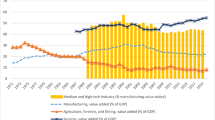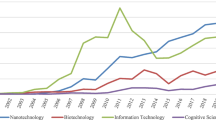Abstract
Technology spillovers have the substantial effect on the industrial structure in emerging economies especially from OFDI (Outward Foreign Direct Investment). This research aims to examines the issue on how environmental regulation and biased policies can more effectively promote the OFDI reverse technology spillover effect, specifically the technology spillovers. By classifying the key industries mentioned in the ‘12th Five-Year Plan’ and ‘13th Five-Year Plan’, this research uses panel data from 2010 to 2019 obtained from provincial OFDI in China and utilizes difference in difference (DID) model and threshold regression approach to validate the analysis. The results show that the key industrial policy is favorable to the local OFDI reverse technology spillover. From the outlook of economic significance, the industrial policy increases the regional OFDI reverse technology spillover by 0.133%. Findings of our study further reveals that the environmental regulation and biased policy effectively promote the regional OFDI reverse technology spillover with certain stability. This study findings will be beneficial for policy makers to stimulate the reverse technology spillover impact of local OFDI more effectively from three aspects such as regional marketization level, innovation ability and financial structure.
Similar content being viewed by others
Data Availability
Data will be available upon request.
References
Abdo ALB, Li B, Zhang X, Lu J, Rasheed A (2020) Influence of FDI on environmental pollution in selected Arab countries: a spatial econometric analysis perspective. Environ Sci Pollut Res 27:28222–28246
Altenburg T, Schmitz H, Stamm A (2008) Breakthrough? China’s and India’s transition from production to innovation. World Dev 36:325–344
An, T., Xu, C., Liao, X., 2021. The impact of FDI on environmental pollution in China: evidence from spatial panel data. Environmental Science and Pollution Research.
Blonigen BA (2016) Industrial policy and downstream export performance. Econ J 126:1635–1659
Braunerhjelm P, Oxelheim L, Thulin P (2005) The relationship between domestic and outward foreign direct investment: the role of industry-specific effects. Int Bus Rev 14:677–694
Chang C-L, Chen S-P, McAleer M (2013) Globalization and knowledge spillover: international direct investment, exports and patents. Econ Innov New Technol 22:329–352
Coe DT, Helpman E (1995) International R&d Spillovers. Eur Econ Rev 39:859–887
Criscuolo, C., Martin, R., Overman, H., Van Reenen, J., 2012. The causal effects of an industrial policy. National Bureau of Economic Research.
Dong F, Zhang S, Li Y, Li J, **e S, Zhang J (2020) Examining environmental regulation efficiency of haze control and driving mechanism: evidence from China. Environ Sci Pollut Res 27:29171–29190
Dong WGaW (2011) Porter hypothesis, environmental regulation and enterprises’ technological innovation; the comparative analysis between central China and eastern China. Chinese Soft Science Journal 1:100–112 (In Chinese)
Fahad S, Bai D, Liu L et al (2021) Heterogeneous impacts of environmental regulation on foreign direct investment: do environmental regulation affect FDI decisions? Environ Sci Pollut Res. https://doi.org/10.1007/s11356-021-15277-4
Fahad S, Wang J (2020) Climate change, vulnerability, and its impacts in rural Pakistan: a review. Environ Sci Pollut Res 27:1334–1338. https://doi.org/10.1007/s11356-019-06878-1
Fahad S, Wang J (2018) Farmers’ risk perception, vulnerability, and adaptation to climate change in rural Pakistan. Land Use Policy 2018(79):301–309
Gong M, Zhen S, Liu H (2021) Research on the nonlinear dynamic relationship between FDI and CO2 emissions in the “One Belt, One Road” countries. Environ Sci Pollut Res 28:27942–27953
Harrison A, Rodríguez-Clare A (2010) Trade, foreign investment, and industrial policy for develo** countries. Handb Dev Econ 5:4039–4214
Huong NTL, Bo YS, Fahad S. Farmers’ perception, awareness and adaptation to climate change: evidence from northwest Vietnam. International Journal of Climate Change Strategies and Management. 2017.
Hsieh C-T, Klenow PJ (2009) Misallocation and manufacturing TFP in China and India. Q J Econ 124:1403–1448
Huang S-C (2013) Capital outflow and R&D investment in the parent firm. Res Policy 42:245–260
Inglesi-Lotz R, Ajmi AN (2021) The impact of electricity prices and supply on attracting FDI to South Africa. Environ Sci Pollut Res 28:28444–28455
Jahanger A (2021) Influence of FDI characteristics on high-quality development of China’s economy. Environ Sci Pollut Res 28:18977–18988
Kiyota K, Okazaki T (2016) Assessing the effects of Japanese industrial policy change during the 1960s. J Jpn Int Econ 40:31–42
Kogut, B., Chang, S.-J., 1990. Technological capabilities and Japanese direct investment into the United States. US-Japan Management Studies Center, Wharton School of the University of
Krueger AO, Tuncer B (1982) An empirical test of the infant industry argument. Am Econ Rev 72:1142–1152
Lall S (2013) Reinventing industrial strategy: the role of government policy in building industrial competitiveness. Ann Econ Financ 14:785–829
Livesey F (2012) Rationales for industrial policy based on industry maturity. J Ind Compet Trade 12:349–363
Nadeem AM, Ali T, Khan MTI, Guo Z (2020) Relationship between inward FDI and environmental degradation for Pakistan: an exploration of pollution haven hypothesis through ARDL approach. Environ Sci Pollut Res 27:15407–15425
Nunn N, Trefler D (2010) The structure of tariffs and long-term growth. Am Econ J Macroecon 2:158–194
Ozturk Ilhan (2011) The macroeconomic effects of IMF programs in Mena countries. Afr J Bus Manag 5(11):4379–87 (SSCI)
Ozturk I (2016) The relationships among tourism development, energy demand and growth factors in developed and develo** countries. Int J Sust Dev World 23(2):122–131
Ozturk I (2017a) Measuring the impact of alternative and nuclear energy consumption, carbon dioxide emissions and oil rents on specific growth factors in the panel of Latin American countries. Prog Nucl Energy 100:71–81
Ozturk I (2017b) The dynamic relationship between agricultural sustainability and food energy-water poverty in a panel of selected sub-Saharan African countries. Energy Policy 107:289–299
Pack H, Saggi K (2006) Is there a case for industrial policy? A critical survey. World Bank Res Obs 21:267–297
Potterie BvPdl, Lichtenberg F (2001) Does foreign direct investment transfer technology across borders? Rev Econ Stat 83:490–497
Qamruzzaman, M., 2021. Nexus between environmental quality, institutional quality and trade openness through the channel of FDI: an application of common correlated effects estimation (CCEE), NARDL, and asymmetry causality. Environmental Science and Pollution Research.
Ren, Y.-S., Apergis, N., Ma, C., Baltas, K., Jiang, Y., Liu, J.-L., 2021. FDI, economic growth, and carbon emissions of the Chinese steel industry: new evidence from a 3SLS model. Environmental Science and Pollution Research.
Sabir S, Qayyum U, Majeed T (2020) FDI and environmental degradation: the role of political institutions in South Asian countries. Environ Sci Pollut Res 27:32544–32553
Seyoum M, Wu R, Yang L (2015) Technology spillovers from Chinese outward direct investment: the case of Ethiopia. China Econ Rev 33:35–49
Shi X, Xu Z (2018) Environmental regulation and firm exports: evidence from the eleventh Five-Year Plan in China. J Environ Econ Manag 89:187–200
Stiglitz, J.E., 2017. Industrial policy, learning and development.
Udemba, E.N., 2021. Mitigating environmental degradation with institutional quality and foreign direct investment (FDI): new evidence from asymmetric approach. Environmental Science and Pollution Research.
Wang H, Liu H (2019) Foreign direct investment, environmental regulation, and environmental pollution: an empirical study based on threshold effects for different Chinese regions. Environ Sci Pollut Res 26:5394–5409
Zameer H, Yasmeen H, Zafar MW, Waheed A, Sinha A (2020) Analyzing the association between innovation, economic growth, and environment: divulging the importance of FDI and trade openness in India. Environ Sci Pollut Res 27:29539–29553
Zhang Cheng ZQ, Tongshen Yu (2011) Relationship between environmental pollution and economic growth. Stat Res J 28(1):59–67 (In Chinese)
Funding
This research is funded by Humanities and Social Sciences Planning Project of Ministry of Education Grant No. 18XJAGJW001 and National Social Sciences Project Grant No. 20BJY090.
Author information
Authors and Affiliations
Contributions
All authors made significant contributions to the study conception and design. Data collection and methodology were performed by D.B. and L.C.L. S.F. did formal analysis and software. S.F. and D.B wrote the original draft. Review and editing were performed by D.B. and V.D.
Corresponding author
Ethics declarations
Ethics approval and consent to participate
Not applicable.
Consent for publication
Not applicable.
Competing interests
The authors declare no competing interests.
Additional information
Responsible Editor: Ilhan Ozturk
Publisher’s Note
Springer Nature remains neutral with regard to jurisdictional claims in published maps and institutional affiliations.
Shah Fahad, Dongbei Bai and Lingcai Liu contributed equally to this paper.
Rights and permissions
About this article
Cite this article
Fahad, S., Bai, D., Liu, L. et al. Comprehending the environmental regulation, biased policies and OFDI reverse technology spillover effects: a contingent and dynamic perspective. Environ Sci Pollut Res 29, 33167–33179 (2022). https://doi.org/10.1007/s11356-021-17450-1
Received:
Accepted:
Published:
Issue Date:
DOI: https://doi.org/10.1007/s11356-021-17450-1




